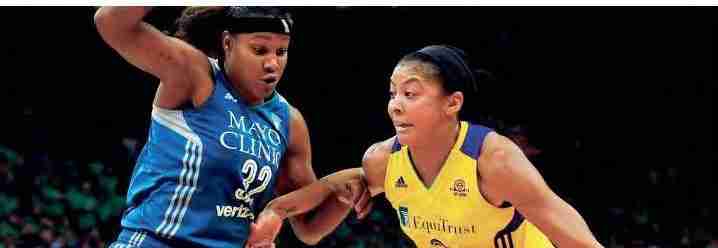WNBA players face off.
The league earned a combined “A” grade for racial and gender diversity in its hiring practices, according to a report card issued Wednesday by The Institute for Diversity and Ethics in Sports (TIDES).
The league earned an Aplus for racial hiring practices and an A for gender hiring practices.
Each of the last 13 years, the WNBA has received an A or an A-plus for its overall race, gender and combined grade from TIDES, which is based at the University of Central Florida.
“It shows that from Day One when the league opened, they made it a priority that first of all they would hire the best people possible at all positions, and also would make it as diverse and inclusive as possible,” said Richard Lapchick, the director of TIDES.
Lapchick’s organization has been producing these report cards since 1988.
TIDES now does annual race and gender report cards for the NFL, MLB, NBA, WNBA, MLS, college sports and Associated Press Sports Editor-affiliated newspapers and websites.
The WNBA’s grade actually is a small step down from the combined A-plus it earned last year. The WNBA accumulated 93.7 points in the TIDES rating system, down from 95.5 last year.
Lapchick said the slight resulted drop from changes TIDES made to its grading scale this year that toughened the requirements necessary to earn an A.
“We felt that the standards that we had been using since 1988 were based on the demographics of the country in 1988, which have obviously changed dramatically,” Lapchick said.
The WNBA still received a higher number of A’s than any men’s professional league. The only men’s league with comparable ratings was the NBA, which got an A for racial hiring practices and a B for gender hiring practices.
Lapchick noted that because the WNBA is newer than most other professional sports leagues, it began with a “clean slate”
and could make diversity a major priority right from the start. Lapchick noted that TIDES started doing report cards for most other leagues when they were well established and didn’t necessarily have strong records for diversity.
“The WNBA from the start, it had a chance to be a role model, and they’ve fulfilled that promise,” Lapchick said.
According to the report card, 11 women and nine people of color held ownership positions. Last year, there were 14 women and seven people of color in those roles.
There were five African American head coaches this season, up two from last year. Six head coaches were women, one more than last year. The list of WNBA CEOs or presidents included five women and three people of color.
The WNBA’s diversity is perhaps most notable at the assistant coach level. People of color held 53.8 percent of the assistant coaching positions, which set a record. Women make up 61.5 percent of the league’s assistant coaches.
The percentage of women holding professionallevel staff positions in the WNBA league office dropped from 69.6 percent in 2016 to 54 percent.
On the other hand, the percentage of people of color in those positions rose from 26.1 percent to 51.2 percent.
Lapchick said the WNBA still has room for improvement in getting the individual team franchises to give more senior-level positions for women.
“This is true across all the other (leagues’) report cards we do as well, that women and people of color are generally under-represented in senior administrative position categories on the team level,” Lapchick said.









No Comment